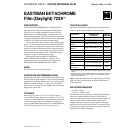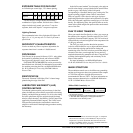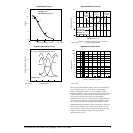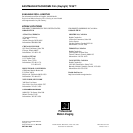
2 EASTMAN EKTACHROME Film (Daylight) 7239™ • H-1-5239
EXPOSURE TABLE FOR DAYLIGHT
At 24 frames per second (fps), 170˚ shutter opening:
Use this table for average subjects that contain a
combination of light, medium, and dark colors. When a
subject includes only pastels, use at least
1
⁄
2
stop less
exposure; dark colors require
1
⁄
2
stop more exposure.
Lighting Contrast
The recommended ratio of key-light-plus-fill-light to fill
light is 2:1 or 3:1; you may use a 4:1 ratio if you want a
special look.
RECIPROCITY CHARACTERISTICS
You do not need any filter or exposure adjustments for
exposure times from 1 second to 1/10,000 second.
PROCESSING
This film may be processed in Process VNF-1, using either
ferricyanide or persulfate bleach, and in Process RVNP.
Force processing beyond 2 stops is not recommended.
EASTMAN EKTACHROME Film can be processed by
the individual user, ifdesired. For information on procedures
for machine processing the film, see KODAK Publication
No. H-24, Manual for Processing EASTMAN Motion
Picture Films.
IDENTIFICATION
The words “Eastman VND Safety Film” is latent-image
printed along the edge of the film.
LABORATORY AIM DENSITY (LAD)
CONTROL METHOD
To maintain optimum quality and consistency in the final
prints, the laboratory must carefully control the color timing,
printing, and duplicating procedures. To aid in color timing
and curve placement, negative originals should be timed
relative to the Laboratory Aim Density (LAD) Control Film
supplied by Eastman Kodak Company. The LAD Control
Film provides both objective sensitometric control and
subjective verification of the duplicating procedures used by
the laboratory.
Lens Aperture
f/
1.4
f/
2
f/
2.8 f/4
f/
5.6
f/
8
f/
11
Footcandles
required
16 32 63 125 250 500 1000
In the LAD control method,
*
the electronic color analyzer
used for color timing is set up with the LAD Control Film to
produce a gray video display of the LAD patch,
corresponding to 1.0 neutral density (gray) on the print. The
negative printing original is then scene-to-scene timed.
There are specific LAD values for each type of print or
duplicating film that the original can be printed on. For print
films, the LAD patch is printed to a neutral gray of 1.0 visual
density. For duplicating films, the specified aims are at the
center of the usable straight-line portion of the sensitometric
curve of the film.
FILM TO VIDEO TRANSFER
When you transfer the film directly to video, you can set up
the telecine with a negative Telecine Analysis Film (TAF)
supplied by Eastman Kodak Company. The TAF consists of
a neutral density scaleandan eight-bar color test pattern with
a LAD gray surround.
The TAF gray scale provides the telecine operator
(colorist) with an effective way to adjust subcarrier balance
and to center the telecine controls before timing and
transferring a film. The TAF color bars provide the utility of
electronic color bars, even though they do not precisely
match the electronically generated colorbars.Using the TAF
will help obtain optimum quality and consistency in the
film-to-video transfer.
For more information, see KODAK Publication
No. H-822, KODAK Telecine Analysis Film User’s Guide.
IMAGE STRUCTURE
The modulation-transfer curve, the diffuse rms granularity,
and the resolving-power data were generated from samples
of 7239 Film exposed to daylight and processed as
recommended in Process VNF-1. For more information on
image-structure characteristics, see KODAK Publication
No. H-1, KODAK Motion Picture Film.
* The LAD control method is described in the paper “A Simplified
Motion-Picture Laboratory Control Method for Improved Color
Duplication,” by John P. Pytlak and Alfred W. Fleischer in the
October 1976 SMPTE Journal. Also refer to KODAK Publication
No. H-61, LAD—Laboratory Aim Density.
Diffuse RMS Granularity* 14
* Read at a net diffuse visual density of 1.0, using a
48-micrometer aperture.
Resolving Power†
† Determined according to a method similar to the one described
in ISO 6328-1982,
Photography—Photographic Materials—
Determination of ISO Resolving Power.
TOC 1.6:1
TOC 1000:1
40 lines/mm
100 lines/mm






